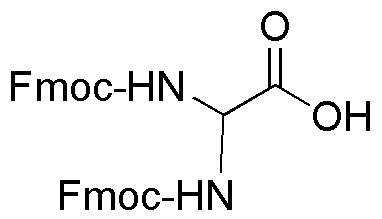N,N'-bis-Fmoc-diaminoacetic acid is widely utilized in research focused on
- Peptide Synthesis: This compound serves as a protecting group in peptide synthesis, allowing for the selective modification of amino acids. Its stability under various conditions makes it ideal for complex peptide chains.
- Drug Development: In pharmaceutical research, it aids in the design of peptide-based drugs, enhancing the efficacy and specificity of therapeutic agents while minimizing side effects.
- Bioconjugation: It is used in bioconjugation processes to attach biomolecules to surfaces or other molecules, facilitating the development of targeted drug delivery systems and diagnostic tools.
- Research in Molecular Biology: This compound plays a crucial role in molecular biology studies, particularly in the synthesis of modified peptides for studying protein interactions and functions.
- Custom Synthesis Services: Many chemical suppliers offer custom synthesis services using this compound, enabling researchers to obtain tailored products that meet specific experimental needs.
Informations générales
Propriétés
Sécurité et réglementation
Applications
N,N'-bis-Fmoc-diaminoacetic acid is widely utilized in research focused on
- Peptide Synthesis: This compound serves as a protecting group in peptide synthesis, allowing for the selective modification of amino acids. Its stability under various conditions makes it ideal for complex peptide chains.
- Drug Development: In pharmaceutical research, it aids in the design of peptide-based drugs, enhancing the efficacy and specificity of therapeutic agents while minimizing side effects.
- Bioconjugation: It is used in bioconjugation processes to attach biomolecules to surfaces or other molecules, facilitating the development of targeted drug delivery systems and diagnostic tools.
- Research in Molecular Biology: This compound plays a crucial role in molecular biology studies, particularly in the synthesis of modified peptides for studying protein interactions and functions.
- Custom Synthesis Services: Many chemical suppliers offer custom synthesis services using this compound, enabling researchers to obtain tailored products that meet specific experimental needs.
Documents
Fiches de données de sécurité (FDS)
La FDS fournit des informations de sécurité complètes sur la manipulation, le stockage et l’élimination du produit.
Spécifications du produit (PS)
Le PS fournit une description complète des propriétés du produit, notamment sa composition chimique, son état physique, sa pureté et les exigences de stockage. Il détaille également les plages de qualité acceptables et les applications prévues du produit.
Certificats d'analyse (COA)
Recherchez des certificats d'analyse (COA) en saisissant le numéro de lot du produit. Les numéros de lot et de lot se trouvent sur l'étiquette d'un produit, après les mots « Lot » ou « Lot de fabrication ».
Numéro de catalogue
Numéro de lot/série
Certificats d'origine (COO)
Ce certificat d'exploitation confirme le pays dans lequel le produit a été fabriqué, et détaille également les matériaux et composants utilisés et s'il est issu de sources naturelles, synthétiques ou autres sources spécifiques. Ce certificat peut être requis pour les douanes, le commerce et la conformité réglementaire.
Numéro de catalogue
Numéro de lot/série
Fiches de données de sécurité (FDS)
La FDS fournit des informations de sécurité complètes sur la manipulation, le stockage et l’élimination du produit.
DownloadSpécifications du produit (PS)
Le PS fournit une description complète des propriétés du produit, notamment sa composition chimique, son état physique, sa pureté et les exigences de stockage. Il détaille également les plages de qualité acceptables et les applications prévues du produit.
DownloadCertificats d'analyse (COA)
Recherchez des certificats d'analyse (COA) en saisissant le numéro de lot du produit. Les numéros de lot et de lot se trouvent sur l'étiquette d'un produit, après les mots « Lot » ou « Lot de fabrication ».
Numéro de catalogue
Numéro de lot/série
Certificats d'origine (COO)
Ce certificat d'exploitation confirme le pays dans lequel le produit a été fabriqué, et détaille également les matériaux et composants utilisés et s'il est issu de sources naturelles, synthétiques ou autres sources spécifiques. Ce certificat peut être requis pour les douanes, le commerce et la conformité réglementaire.


